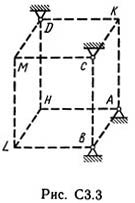- Arts & Culture 6204
- Business & Economics 676
- Computers 329
- Dictionaries & Encyclopedias 70
- Education & Science 76847
- Abstracts 73
- Astrology 4
- Biology 8
- Chemistry 3920
- Coursework 15556
- Culture 8
- Diplomas 316
- Drawings 1596
- Ecology 5
- Economy 81
- English 80
- Ethics, Aesthetics 3
- For Education Students 17651
- Foreign Languages 11
- Geography 3
- Geology 1
- History 88
- Maps & Atlases 5
- Mathematics 12624
- Musical Literature 2
- Pedagogics 19
- Philosophy 22
- Physics 15120
- Political Science 5
- Practical Work 59
- Psychology 65
- Religion 4
- Russian and culture of speech 8
- School Textbooks 7
- Sociology 9
- Summaries, Cribs 87
- Test Answers 160
- Tests 8753
- Textbooks for Colleges and Universities 32
- Theses 7
- To Help Graduate Students 14
- To Help the Entrant 38
- Vetting 382
- Works 13
- Информатика 8
- Engineering 872
- Fiction 708
- House, Family & Entertainment 84
- Law 133
- Website Promotion 70
Solution C3-34 (Figure C3.3 condition 4 SM Targ 1989)
Content: s3-34.doc.RAR 22,96 kB
| 200 $ | the discount is | 15% |
| show all discounts | ||
| 1 $ | the discount is | 1% |
Seller will give you a gift certificate in the amount of
Product description
Solution C3-34 (Figure C3.3 condition 4 SM Targ 1989)
Six weightless rods are connected by their ends to each other in two knots and fixed at their other ends (also hinged) to the fixed supports A, B, C, D (Figure C3.0-C3.9, Table C3). Rods and knots (nodes are located at the vertices of H, K, L or M rectangular parallelepiped) in the figures are not shown and should be depicted as solving the problem according to the table. In the node, which is indicated first in each column of the table, a force P = 200 N is applied; The force P forms, with positive directions of the coordinate axes x, y, z, the angles equal to respectively α1 = 45 °, β1 = 60 °, γ1 = 60 °, and the force Q - the angles α2 = 60 °, β2 = 45 °, γ2 = 60 °; The directions of the x, y, and z axes for all the figures are shown in Fig. CZ.0. The faces of the parallelepiped parallel to the xy plane are squares. The diagonals of the other lateral faces form an angle φ = 60 ° with the xy plane, and the diagonal of the parallelepiped forms an angle θ = 51 ° with this plane. Determine the forces in the rods. In Fig. C3.10 shows, as an example, how the S3 drawing should look. 1, if by the conditions of the problem the nodes are at the points L and M, and the rods are LM, LA, LB; MA, MS, MD. The angles φ and θ are also shown there.
Feedback
0| Period | |||
| 1 month | 3 months | 12 months | |
| 0 | 0 | 0 | |
| 0 | 0 | 0 | |

